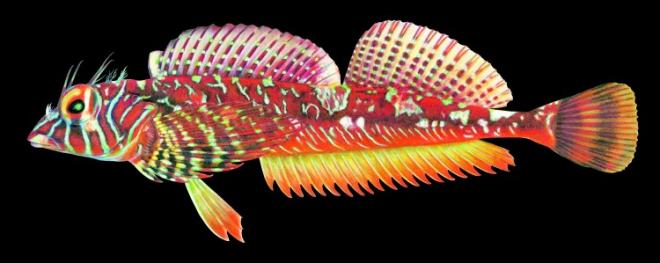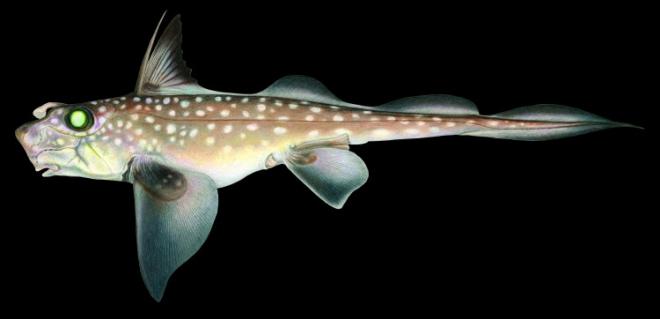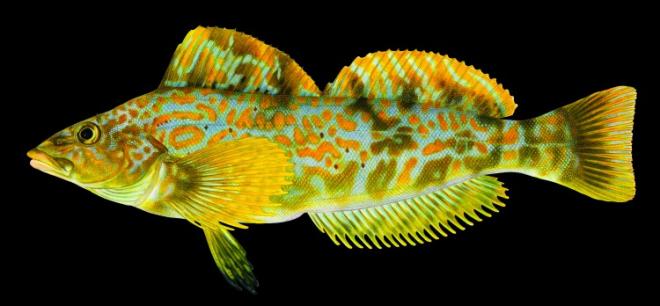List of Salish Sea fish grows to 253 species
Researchers updating a 1980 fish catalog have found evidence of 37 additional fish species in the Salish Sea. This information, accompanied by hundreds of detailed illustrations, is seeding a new reference book expected to gain wide use among scientists, anglers and conservationists. [Editor's note: As of 2019, the list of Salish Sea fishes has grown to 260 species.]

Every species of fish ever known to exist in Puget Sound—from the streamlined sockeye salmon to the ornately finned fourhorn poacher—is listed in a new report published online by the National Marine Fisheries Service.
“We turned over every stone to make sure that the list we have is accurate,” said the report’s co-author Ted Pietsch, who recently retired as curator of fishes at the University of Washington’s Burke Museum of Natural History and Culture.
The report documents 253 fish species found in the Salish Sea, which includes the Strait of Georgia in British Columbia as well as the inland waterway of Washington State. Ranging from ordinary to truly strange fish, the new list adds 37 species not found in a previous catalog compiled in 1980 — the most comprehensive list available until now.
Upcoming book
The new list, which includes notes about where specific fish have been found, is a precursor to an upcoming book [published in 2019] expected to exceed 600 pages, including detailed full-color illustrations of every fish and at least two pages of information on each one.
“The nearly completed manuscript goes well beyond the distribution of the fish,” Pietsch said. “We talk about biology and behavior and habitat….”
He expects the book to be a welcome resource for scientists, anglers and conservationists, as well as anyone interested in the variety of strange and colorful fish confirmed as residents of the Salish Sea.
Researchers who catch fish to monitor their population changes will use the book to identify any unusual fish that comes to the surface in their nets, he said.
“If you don’t know what is there, you can’t expect to monitor how a population is changing,” he noted.
Populations in a given area are never static, and climate change could bring more dramatic shifts in the kinds of fish living in the Salish Sea, he said. Species common in other areas may move into the inland waterway in greater numbers, while some established species may decline or even disappear as a result of changes in temperature, salinity and acidity.

This new list of known fish is not a snapshot of today’s Salish Sea populations but rather a record of the fish that have been found at one time or another and may still be lurking in local waters.
Of all the fish on the list, only one — the blackfin sculpin — is believed to live in the Salish Sea and nowhere else.
The book will include a variety of names associated with each fish and point readers to the official common name adopted by the American Fisheries Society.
“You’ll be able to choose the proper name,” Pietsch said. “Many things have been misidentified, and crazy names have been posted. A single species can have half a dozen different names.”
New illustrations
To help in identification, nothing may be better than the hundreds of anatomically precise illustrations being created by Joe Tomelleri, who has specialized in drawing fish for the past 30 years. Based in Leawood, Kansas, Tomelleri has provided fish pictures to more than 1,000 books and magazines.

“Puget Sound is probably the most difficult work I’ve done,” Tomelleri said of the upcoming book on fish of the Salish Sea. “Saltwater fish are so varied and so difficult to do in terms of anatomy. They are all over the board.”
Some fish have long fins; some have short fins, he said. Some have spines coming off them, and some even have plates.
For salmon of the Salish Sea, Tomelleri has shown each species in its “bright” ocean coloration as well as its subdued spawning colors.
Drawing the scales of each fish at their correct size and aligned in an exact number of rows is a key part of the effort. Tomelleri works from specimens sent to him in jars or otherwise preserved along with color photographs of freshly caught fish.
“It is almost imperative that you get photographs when the fish are fresh, because some will start to change color almost immediately,” he said. “With some live fish, you could put them in a light-colored bucket and they will start to lighten up in color.”
Tomelleri begins by drawing the basic outlines in pencil, filing in the details with color pencils and occasional underpainting with water color. Depending on the fish, each scale may get four or five colors.
Larger fish with more detailed anatomy take longer to complete, he said, noting that he recently spent 60 hours drawing and coloring a single fish. The average time is perhaps 20 to 25 hours, he said.
Tomelleri retains the copyright to his illustrations so that he can use them again in other publications. He also sells high-quality prints of fish for framing along with posters.
He said he likes rockfish, which come in all varieties in the Salish Sea. Perhaps his favorite fish, however, is the kelp poacher, a fish mottled in orange, red and brown and displaying ornate fins. Found in rocky areas, the kelp poacher uses its pectoral fins to climb around on rocks.
Examining the evidence
For a species to make it to the list of fish from the Salish Sea, solid proof was demanded by Pietsch and his fellow author, Jay Orr, a researcher with NOAA’s Alaska Fisheries Science Center. They required an actual specimen collected from the waterway or else a high-quality documented photograph. It was not enough for a species to be mentioned in a research paper.

Most of the proof came from the Burke Museum’s vast collection of fish specimens, but evidence also was obtained from numerous other collections, including the Canadian Museum of Nature in Ottawa, the University of British Columbia in Vancouver, the Royal British Columbia Museum in Victoria, the California Academy of Sciences in San Francisco and the Los Angeles County Museum of Natural History.
Five species of fish were removed from the list compiled in 1980 after extensive research could provide no solid evidence that the fish ever lived in the Salish Sea, Pietsch said.
And, surprisingly, since the latest list was completed within the past month, evidence of three more species of fish have come to light. Old records were traced to specimens collected 150 years ago and still stored in the Natural History Museum of London. Those fish will be included in the book, along with illustrations, and added to the Burke Museum’s database of known species from the Salish Sea.
Funding for the project was provided by the SeaDoc Society, a conservation and research organization supported by the University of California at Davis.




